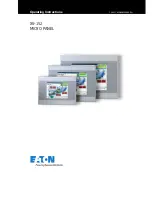
Temperature
Compensating Type
High Dielectric
Constant Type
1 Operating
-
55
℃
to 125
℃
R6 :
-
55
℃
to 85
℃
Reference Temperature : 25
℃
Temperature Range
R7 :
-
55
℃
to 125
℃
C8 :
-
55
℃
to 105
℃
E4 : 10
℃
to 85
℃
F5 :
-
30
℃
to 85
℃
L8, R9 :
-
55
℃
to 150
℃
2 Rated Voltage
See the previous pages.
The rated voltage is defined as the maximum voltage which may be applied
continuously to the capacitor.
When AC voltage is superimposed on DC voltage, V
P-P
or V
O-P
, whichever is
larger, should be maintained within the rated voltage range.
3 Appearance
No defects or abnormalities.
Visual inspection.
4 Dimension
Within the specified dimensions.
Using calipers.
(GRM02 size is based on Microscope.)
5 Dielectric Strength
No defects or abnormalities.
No failure should be observed when 300% of the rated voltage
(ΔC to 7U and 1X) or 250% of the rated voltage (R6,R7,C8,E4,F5,L8 and R9)
is applied between the terminations for 1 to 5 seconds, provided the
charge/discharge current is less than 50mA.
6 Insulation Resistance
More than 10,000M
Ω or 500Ω
∙
F
The insulation resistance should be measured with a DC voltage
(whichever is smaller)
not exceeding the rated voltage at 25
℃
and 75%RH max.
and within 2 minutes of charging, provided the charge/discharge
current is less than 50mA.
7 Capacitance
Within the specified tolerance.
The capacitance/Q/D.F. should be measured at 25
℃
at the frequency
and voltage shown in the table.
8 Q/
30pF and over:Q
≧
1000
[
R6,R7,C8,L8
]
(1)Temperature Compensating Type
Dissipation Factor (D.F.)
30pF and below:Q
≧
400+20C
W.V.:100V : 0.025max.(C
<
0.068
m
F)
: 0.05max.(C
≧
0.068
m
F)
C:Nominal Capacitance(pF)
W.V.:50V/25V : 0.025max.
W.V.:16V/10V : 0.035max.
W.V.:6.3V/4V : 0.05max.(C
<
3.3
m
F)
: 0.1max.(C
≧
3.3
m
F)
(2)High Dielectric Constant Type
[R9]
W.V.:50V : 0.05max.
[E4]
W.V.:25Vmin : 0.025max.
[F5]
W.V.:25Vmin : 0.05max. (C
<
0.1
m
F)
: 0.09max.(C
≧
0.1
m
F)
W.V.:16V/10V : 0.125max.
W.V.:6.3V : 0.15max.
9
Capacitance
No bias
Within the specified
R6 : Within ±15%
The capacitance change should be measured after 5min. at each
Temperature
tolerance.(Table A-1)
(-55°C to +85°C)
specified temp. stage.
Characteristics
R7 : Within ±15%
(-55°C to +125°C)
(1)Temperature Compensating Type
C8 : Within ±22%
The capacitance drift is calculated by dividing the differences between
(-55°C to +105°C)
the maximum and minimum measured values in the step 1,3 and 5
Capacitance Drift *
L8 : Within ±15%
by the cap. value in step 3.
Within ±0.2% or ±0.05pF
(-55°C to +125°C)
(Whichever is larger.)
: 15/-40%
*Not apply to 1X/25V
(+125°C to +150°C)
R9 : Within ±15%
(-55°C to +150°C)
E4 : 22/-56%
(+10°C to +85°C)
F5 : 22/-82%
(-30°C to +85°C)
(2)High Dielectric Constant Type
Temp. of Step 2 : R7,R6,C8,L8,R9 : -55±3°C
E4 : +10±3°C
F5 : -30±3°C
Temp. of Step 4 : R7 : +125±3°C
R9,L8 : +150±3°C
R6,E4,F5 : +85±3°C
C8 : +105±3°C
・
Initial measurement for high dielectric constant type
Perform a heat treatment at 150 +0/-10°C for one hour and
then set for 24±2 hours at room temperature.
Perform the initial measurement.
10 Adhesive Strength
No removal of the terminations or other defect should occur.
Solder the capacitor on the test jig(glass epoxy board) shown in Fig.3
of Termination
using a eutectic solder.
Then apply 10N* force in parallel with the test jig for 10±1sec.
The soldering should be done either with an iron or using the reflow
method and should be conducted with care so that the soldering is
uniform and free of defects such as heat shock.
*1N(GRM02), 2N(GRM03), 5N(GRM15,GRM18)
■
SPECIFICATIONS AND TEST METHODS
No
Item
Specification
Test Method
Step
Temperature(
C)
1
25±2
2
-55±3
3
25±2
4
125±3(for ΔC)
85±3(for other TC)
5
25±2
Capacitance
Frequency
Voltage
C
≦
10μF
1±0.1kHz
1±0.2Vrms
C
>
10μF
120±24Hz
0.5±0.1Vrms
E4
1±0.1kHz
0.5±0.05Vrms
Capacitance
Frequency
Voltage
C
≦
1000pF
1±0.1MHz
0.5 to 5Vrms
C
>
1000pF
1±0.1kHz
1±0.2Vrms
Step
Temperature(
C)
1
25±2
2
Min.Operating Temp.±3
3
25±2
4
Max.Operating Temp.±3
5
25±2
JEMCGS-00074C
2



































